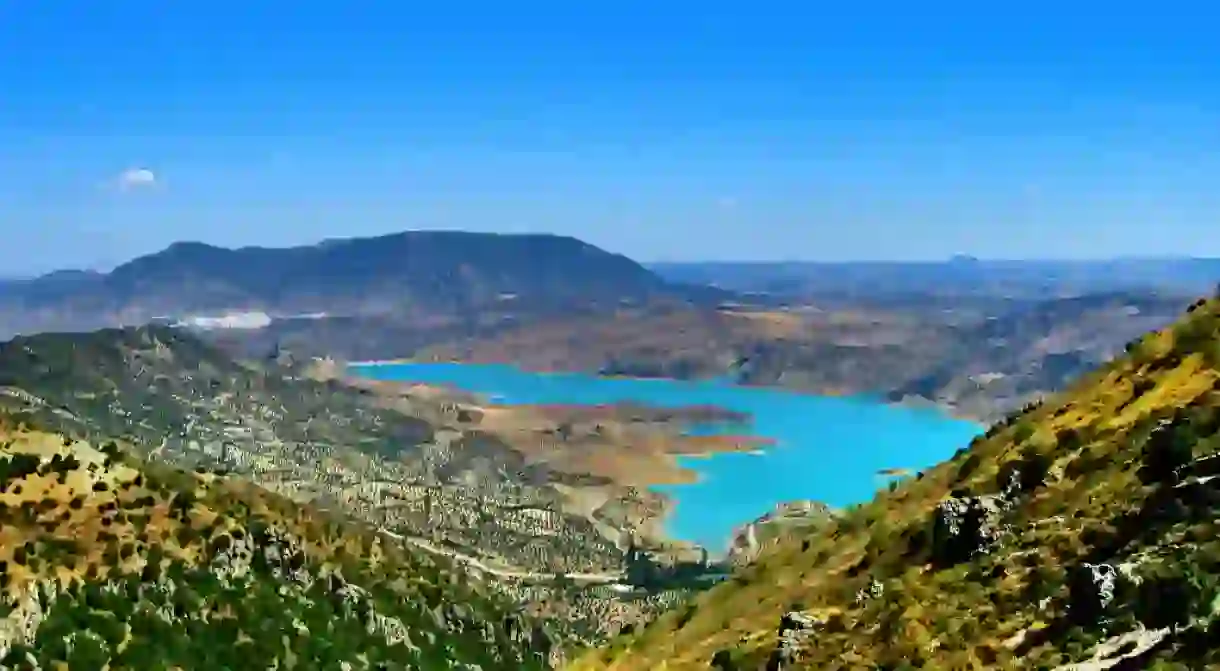10 Things to Know Before Trekking in Andalusia's Grazalema Natural Park

Named as a UNESCO Biosphere Reserve in 1977 and Andalusia’s first natural park in 1984, the Sierra de Grazalema is one of Spain’s most spectacular protected areas. Featuring rugged limestone mountains, turquoise lakes, lush forests and soaring birds of prey, it’s a must-visit if you’re in Ronda, which is located just 34 kilometres (21 miles) to the east. Read on for 10 things you should know before trekking in this beautiful natural park.
It’s easy to reach from Ronda
The Sierra de Grazalema is easily reached by car from the stunning hilltop town of Ronda. To the beautiful village of Grazalema itself, which lies in the middle of the park, it’s a half-hour drive of 34 kilometres (21 miles). Join the A374 out of Ronda (via Avenida Málaga), then take the A372. The scenery that surrounds you on this drive is so spectacular that it might be a challenge to keep your eyes on the road. There are also usually a couple of buses a day from Ronda to Grazalema and vice versa.
Some tracks require permits
To regulate the number of trekkers in certain parts of the Grazalema, permits are required for four tracks: Pinsapar, Mount Torreón, La Garganta Verde and Llanos del Rabel. These can be obtained through most hotels in the parks’ pueblos blancos, from the visitor centres in Grazalema and El Bosque, by calling 0034 956 70 97 or by emailing pn.grazalema.cma@juntadeandalucia.es. They are free of charge upon presentation of valid ID, but only a certain number are issued for each day.

The village of Grazalema is beautiful
Before or after trekking, it’s well worth setting aside a couple of hours to spend in the gorgeous village of Grazalema, a picture-perfect patch of whitewashed houses nestling amongst rugged mountains and rolling hills. Its central square faces a beautiful church and is packed with sunny terraces, making it the ideal place for post-trekking drinks and tapas. And from the viewing platform near the parking area you can enjoy humbling views of the park’s untamed expanses.
Some tracks are closed in summer
Because of the risk of forest fires, four of Grazalema’s tracks are closed, partially closed or only walkable with guides from June 15 until October 15. Only the first sections of Pinsapar and La Garganta Verde are accessible between these dates, while the track that leads to the top of Mount Torreón is closed completely. If you’re trekking Los Llanos de Rabel during the summer, hiring a qualified guide is recommended, as is taking plenty of liquids and high-factor suncream.

Majaciete is a wonderful river trek
Happily, one of Grazalema’s least demanding routes is also one of its most beautiful. It starts from the lovely rural village of Benamahona (about a 15-minute drive west of Grazalema) and winds alongside the lush, forested banks of the Majaciete River for a couple of kilometres, taking in gushing waterfalls and tranquil pools along the way. So pure and clean are the waters of the Majaciete that you can see straight to the bottom of even the deepest parts.
You can swim at the Cueva del Gato
One of the Grazalema’s most jaw-dropping natural features is the Cueva del Gato (‘cat’s cave’), the 25-metre- (82-foot)-high entrance to which is said to resemble a feline face. This remarkable complex of underground lakes and caverns opens out onto a crystal-clear pool straight out of The Beach, where you can enjoy some wonderful swimming in summer months. The pool is about a 20-minute drive from Ronda, on the eastern edge of the park.

It’s home to a rare forest of Spanish firs
One of the joys of trekking the Torreón/Pinar track is passing through the carefully preserved forest of Spanish firs that occupies its lower section. This species is descended from the European fir that formed large forests here during the Earth’s glacial periods (the last of which ended about 15,000 years ago) and is one of only three still existing in Spain; the others are found in the Las Nieves natural park the other side of Ronda, and in Málaga’s Bermeja mountains.
Mount Torreón is the highest peak
The highest peak in Grazalema (and in Cádiz province) is Mount Torreón/Pinar, with an elevation of 1,654 metres (5,427 feet). The track that leads to its summit starts about halfway along the road between Grazalema and Benamahona, passing through an otherworldly forest of Spanish firs and a grey, rocky wilderness before reaching the top. The going is not easy on this three-hour trek: from the outset, the climb is steep and the loose rocks along the route’s finale require careful treading. But it’s worth every step.

It supports a rich variety of fauna…
Members of the 130+ species of bird that call the Grazalema park home can be seen on the approach from Ronda, cruising above the mountains in the clear blue sky: these include booted, Bonelli’s and golden eagles, the peregrine falcon and the griffon vulture, the latter of which nest in the Garganta Verde’s vertiginous crags. You may even be lucky enough to see one of the dozen or so pairs of Egyptian vultures that live here – a species whose survival is gravely endangered. Roe deer and Spanish ibex are among Grazalema’s most notable mammals.
… and flora
The Grazalema park is the rainiest part of Spain, and its verdant terrain is therefore able to support over 1,300 species of Mediterranean plant, including 30 species of orchid, as well as a rare forest of Spanish fir, cork groves, poplars, Mediterranean elms and alders. Seven plant species found here – including the lovely Grazalema poppy – exist nowhere else on the planet. This colourful, thriving flora is one of the many reasons why trekking in the Grazalema is such an unforgettable experience.














